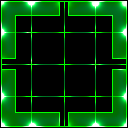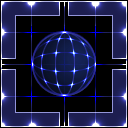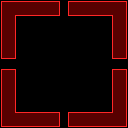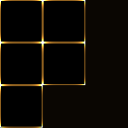Table of Contents
Armada 1 Obscure Game Mechanics
There are some peculiarities of Star Trek: Armada, that are not covered by any manual, but are in fact quite reproducible, so they actually are part of the game mechanics (even when most of them certainly were an unintended effect).
Invisible Shroud
When turning off shroud and fog of war, you basically see the entire map. But that does not mean, you can place special weapons targets, such as Transwarp Gates, Transwarp Drive destinations or Temporal Stasis Fields everywhere by default. In fact the whole map is still covered in shroud, but the shroud was simply turned fully invisible. So you need to scout a place first (or get a visual using Shrike's Romulan Spy or capturing an opponent's facility). Once you »uncovered« a section of the map, you can use whatever special ability can reach that far. Similar considerations got for building a station. Unscouted parts of the map will be marked as none-buildable, although a specific location may very well allow for construction of stations.
Cloaked But not Invisible
When turning off the fog of war, cloaked ships will still appear visible for an opponent, once inside the already visible map space of him. You will still need to use a detector to uncover the »invisible« unit, in order to be able to target it. You will however, not need to uncover it in order to beam in…
Line of Sight of a Team Member is not Shown Entirely
Usually you can see all that your team members see, too. This goes with one exception: If a part is uncovered for a player only due to an active Romulan Spy, then these units and stations are not part of the shared line of sight. Meaning a ship that is very much visible for your team mate due to being spied upon is still not visible for you, if it is cloaked.
Freighters Behavior
All Freighters will continue gathering Dilithium from a newly chosen Dilithium Moon, once the Moon they are working on runs dry. They will select the nearest Moon still having Dilithium. That usually leads to the situation, that two empty Freighters and one partially filled one will head into the direction of a new moon. They will gather Dilithium there and return it to the Mining Station they were returning the Ore to before. If that partially filled Freighter does empty entirely and stay at the Mining Station instead of heading out and filling the rest of their cargo hold, you can be sure that there is no Dilithium out there anywhere any more.
Discovering Cloaked Ships without a Tachyon Detection Grid
There are several ways to discover cloaked ships without actually having a detector unit or building uncovering it.
- Some special weapons, like the Griffin's Sensor Jammer, directly affect (if limited in numbers, randomly selected) opposing units, even when cloaked. This in turn usually makes the unit uncloak.
- When using the build command and trying to traverse the screen with the mouse, you might find spots that you can normally build on the map, but for some reason, you cannot at the moment. Send a detector there, or a unit, that can attack cloaked units, to uncover it. Similarly when building facilities, you are not allowed to build on top of positioned ships. This also goes for opposing cloaked ships… Do not confuse this with the case of section Building Near Nebulae Impossible. Also it is known to happen quite frequently, that the construction ship itself is blocking its own build spot. So when moving it a bit away, you might find that you can indeed build on a position, that the game announced to be blocked from building on.
- When moving your own ships and finding they seem to avoid a specific spot (similarly as when you send them very closely to one of your stations, so they go around it), it is also very likely, that there is a cloaked unit waiting.
Placing Buildings
In general, buildings can be placed on the most part of the map. Before eventually giving the building command, the mouse pointer must be placed over a suitable position on the map. The depiction of the construction possibilities can be indicated by one of the following four depictions:
Building Really Tightly
By default every building and all map items are surrounded by a non-build area (gold grid), when trying to place a new building. You cannot build a new building inside such an area, not even partially overlapping it. But once you place a Transwarp Gate destination on such an area and the destination end of the gate is removed (end of special energy or deactivating the Transwarp Gate manually), the blocking grid disappears. So you are able to build facilities a lot close together than normally, once this blockade is gone. The lower limit is placing buildings directly adjacent. They cannot overlap, but they can be placed right next to each other. Each newly built building will again exhibit the build blocking, as is normally applied by creating a new building. So you might need to use the Transwarp Gate multiple times, to place more than two stations right next to one another.
Building Near Nebulae Impossible
Although there is a depiction of allowed and forbidden areas for building new facilities (yellow grid) this is not entirely accurate. Building inside or close to nebulae is still not possible, even when using the trick from the previous section. As a matter of fact, even the starting grid limitations are not covering the whole range of no-build-areas around nebulae. There is no other way than moving around with your mouse, in order to find the nearest spot to be build next to a nebula.
Raising Shields Will not Stop the Beam-in
By default, your ships cannot beam in crew into opposing ships, that have their shields raised. That's normal behavior. But once you started beaming in, the beaming will only stop, when you run out of crew, the destination ship is full, the source ship gets destroyed or leaves beaming range or you stopped it manually. This also goes for the case, if the opposing ship regains shield generators. The shields may be raised, but the beaming continues. Only exception: The shields were dropped by the Shield Disruptor or Cloak.
Firing Stops when You Beam in
If your ships are around an opposing ship, engaged in firing at it and one of your ships manages to beam crew over, all your ships and stations stop firing at that ship, until you explicitly tell one of them to do so. Once you attack with one ship or station, all ships in firing range and on read alert will continue firing. A similar behavior is seen when using the Borg's Holding Beam.
The AI Cheats
The AI is actually not that smart, no matter the difficulty. The difficulty level changes the likelihood of using special weapons and cloak as well as the size of fleets. But in general, it is not really adaptive. It makes up for that lack of skill by simply cheating a lot:
- When playing against a medium or hard AI, you can notice that the build time and resources are considerably lower. For the hard AI it's only 40%, for the medium AI 80% of the normal cost of time and materials.
- All AIs cheat in the way that they disregard the tech tree altogether. That's advantageous and disadvantageous at the same time. While it allows the AI to build mining freighters before even having a mining station, it also makes it waste resources on not required buildings, such as research stations and special weapon research, when playing with Free Tech techtree.
- Also the AI always knows where your ships are, even when they are cloaked (similar how using no fog of war and no shroud works for humans). So when placing a sensor station remotely, where the AI cannot have seen it, it will still head straight for that spot and attack it. You can see that particularly well in the Mission To the Gates of Sto'vo'Kor.
What the AI will not do however, is cheating itself more resources. So it is possible to starve the AI out. As the AI never deconstructs ships or stations, it has no way of recovering, once it has no freighters and less than 160 Dilithium left (to build a new freighter).
Cloaking Uses Energy
Although not explicitly mentioned, when cloaking ships, an amount of 100 special weapon energy is used up at the moment of cloaking. Very often that does not really make a (big) difference, but for some units (e.g. the Raptor class of the Romulan faction) this means after decloaking they will not be able to use their special weapon right away, as the energy is too low. Also when energy is drained and drops to zero, the ship may decloak momentarily, as it happens for instance in the Romulans mission Call to Power.
Phoenix Bug
The Rift Creator of the Phoenix has a control key definition bug. By default, all normal cloaks are used with the F5 key. This also goes for the Phoenix, which actually has a cloak. But as its special weapons F-key slot is also activated by F5, the cloak is not usable for human players. It is neither visible as a button nor can it be used with the F-key. Instead, the super weapon is triggered. The AI on the other hand can use both functions independently, which leaves the AI with the advantage of being able to send the Phoenix into battle cloaked.
Firing on Ones Self Bug
The game does allow for stations and ships to fire on one's own units. When you order a unit that is capable of firing conventional weapons to fire, you can direct that fire explicitly (attack command) onto one of your friendlies. That may be an intended design aspect of the game. (Yet a strange one. If you want to get rid of one of your own units, you simply deconstruct it.) What's very likely not intended, is the ability of ships to actually fire on themselves (not: another friendly ship of sorts).
When having selected more than one ship at the same time, making the group attack a friendly of the group makes all ships attack the target, including the ship being targeted. Even when ceasing fire with the other ships, the ship firing on itself will not stop, until given another order (or weapons fail). So basically you can order a ship to fire on itself. This is not very well visible for Phase fire. But torpedoes make it very well visible, that a ship can in fact fire on itself. This does not work with stations, as you cannot select multiple stations at the same time.
Increased Mining Rate by Death Chant
The increased firing rate caused by a Death Chant also affects the Mining Beam, increasing the output rate by 50%. When having less than 3 freighters at a Dilithium Moon, this may boost income rate. If you already have 3 or more freighters at one moon, there is little point in using this method, as the processing speed of mining stations is not increased, making them the bottle neck.
Beaming in Uncovers Parts of the Map
Although not stated explicitly, when taking over an opponent's facility by beaming in (or using a special weapon that does the same), there is a very high chance, that for a short period of time the opponents facilities and units are uncovered on the entire map. It's similar to the Shrike's Romulan Spy, but will last a lot shorter.
Corbomite Reflector Works Only Partially
Not all weapons are affected by the Corbomite Reflector. See Corbomite Reflector for more details.
Torpedoes and Pulse Weapons Can Miss
While Phasers and Pulse Turret Cannons will never miss (unless the ship traverses through a Wormhole after the weapon fired), torpedoes can and will miss to a certain fraction. This is why the effective damage rate of them is actually lower than what the theoretical damage value states. Torpedoes are however, in general still dealing more effective damage than any other conventional weapon. In fact, one torpedo station will deal more damage per time than an entire starbase. Similarly the pulse weapons of destroyers and scouts have a chance of missing their targets, reducing their nominal damage rate as well.
Units Vanish From Control Groups
When grouping your ships into control groups (CTRL + digit-key), selecting them is supposed to make you get in control of the ships designated to be part of that group. However, once under the effect of the Holo-Emitter or Temporal Stasis Field or the Computer Override, units will no longe be marked when using that digit key. This will return to normal, once the effect of the special weapon wears off.
Units Returning to Control Groups
The opposite is also true. If you lose a ship to an opponent, e.g. by beaming in crew from his ships or using other means of taking over the ship, the control group is actually still stored. Meaning, if you regain control over that ship, it will also be part of the control group once again. Only exception: You were reassigning the control group in the meantime.
Cloaked Phoenix
The AI can cloak Phoenix class ships, but human players cannot. See section Phoenix Bug on the matter.
Klingons Will Fire Faster When Low on Crew
Something that's not mentioned in the manual is the tendency of the Klingon faction, to actually increase their firing rate, when really low on crew (red state) by 33%. All other factions will decrease their weapons firing rate once dropping below a certain number of crew.
Controls
Armada itself has quite an efficient control if you know how to use it. Almost everything in the game is accessible via shortcuts. All special weapons can be triggered via the F keys. Units can be combined with CTRL + <number key> to control groups of up to 8 units and then directly selected as a squad by pressing the corresponding number keys. See also Keyboard Controls.
Exiting Multiplayer Properly
It may seem trivial at first. You just leave the match when you're not up for it anymore. But there are two different methods, which have completely different effects for the remaining players. When you surrender, all your units are actually removed from the game and you're completely out. However, if you abort the mission, you will be out, but a medium AI will take your place. See also section Ingame Main Menu on that.
It does not make a difference whether someone has hosted the game when they quit or not. Only during setting up of the game is the host special. Once the match starts, it is Peer to Peer. So no player has any special role anymore. If the hosting player quits the match, the game just continues. So the game host has no reason to stay in the match if he doesn't feel like it anymore.
Depending on the way he leaves, the game continues with or without AI replacement. Via Gameranger it turned out, however, that you have to give the game a moment, before you click on Quit to Windows at the end of the score screen. If you're too fast here, the match also ends for the other players. So you have to wait a few seconds before quitting the game. This may also depend on the data rate at which you are connected. Such a behavior has not appeared via LAN/VPN, yet.




